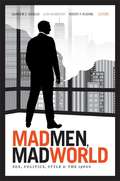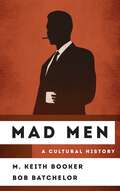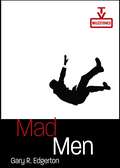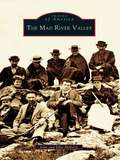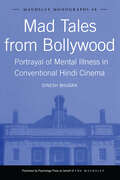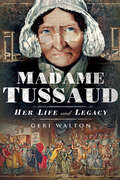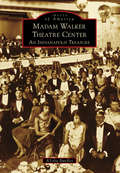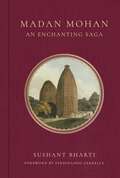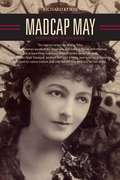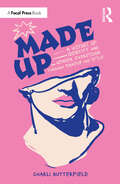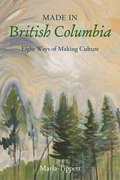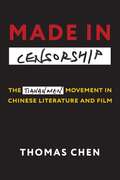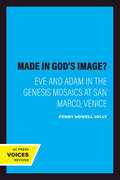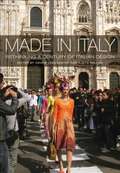- Table View
- List View
Mad Max (Constellations)
by Martyn ConterioMad Max (1979) is a freak picture. Too classy and well-crafted to be lumped in with low-budget Ozploitation titles, yet completely unlike other films made during the 1970s Australian New Wave, George Miller’s directorial debut is a singular piece of action cinema, one that had a major cultural impact and spawned a movie icon in Max Rockatansky (played by Mel Gibson). This monograph examines the film’s considerable formal qualities in detail, including Miller’s theory of cinema as “visual rock ‘n’ roll” and his marriage of classical Hollywood editing and Soviet-style montage. George Miller is arguably the single most important filmmaker in Australia’s history, bringing a commercial and artistic vision to the screen few of his compatriots have ever managed before or since. Taking in everything from the film’s extremely controversial critical reception to its legacy today via a string of sequels and the creation of an entire subgenre—postapocalyptic action—the book is for film students and fans alike.
Mad Men on the Couch: Analyzing the Minds of The Men And Women of The Hit TV Show
by Stephanie NewmanMad Men has captured the imaginations of millions of viewers, winning fifteen golden globes and four Emmys. Perhaps more than the gorgeously stylized visuals and impeccably re-created history, it's the show's richly drawn characters stumbling through their personal and professional lives that get under our skin and keep us invested.In Mad Menon the Couch, Dr. Stephanie Newman analyzes the show's primary characters through the lens of modern psychology. Lending her trained professional eye, she poses and expertly answers pressing questions such as:Why does Don constantly sabotage himself? Why is Betty such a cold mother and desperately unhappy housewife? (Hint: It's not just because her "people are Nordic.")Why does Pete prevail in adversity when Roger crumbles?Why is Peggy able to rise profesionally in the male jungle of Madison Avenue when Joan can't?Can these characters ever really change?With critical commentary that is both entertaining and insightful, Mad Men on the Couch will provide viewers with a unique persepctive on the show.
Mad Men, Mad World: Sex, Politics, Style, and the 1960s
by Lilya Kaganovsky Robert A. Rushing Lauren M. E. GoodladSince the show's debut in 2007, Mad Men has invited viewers to immerse themselves in the lush period settings, ruthless Madison Avenue advertising culture, and arresting characters at the center of its 1960s fictional world. Mad Men, Mad World is a comprehensive analysis of this groundbreaking TV series. Scholars from across the humanities consider the AMC drama from a fascinating array of perspectives, including fashion, history, architecture, civil rights, feminism, consumerism, art, cinema, and the serial format, as well as through theoretical frames such as critical race theory, gender, queer theory, global studies, and psychoanalysis. In the introduction, the editors explore the show's popularity; its controversial representations of race, class, and gender; its powerful influence on aesthetics and style; and its unique use of period historicism and advertising as a way of speaking to our neoliberal moment. Mad Men, Mad World also includes an interview with Phil Abraham, an award-winning Mad Men director and cinematographer. Taken together, the essays demonstrate that understanding Mad Men means engaging the show not only as a reflection of the 1960s but also as a commentary on the present day. Contributors. Michael Bérubé, Alexander Doty, Lauren M. E. Goodlad, Jim Hansen, Dianne Harris, Lynne Joyrich, Lilya Kaganovsky, Clarence Lang, Caroline Levine, Kent Ono, Dana Polan, Leslie Reagan, Mabel Rosenheck, Robert A. Rushing, Irene Small, Michael Szalay, Jeremy Varon
Mad Men: A Cultural History (The Cultural History of Television)
by M. Keith Booker Bob Batchelor&“A comprehensive examination of the ways in which [the series] uses American cultural memory . . . to shape . . . characters&’ developments and the narrative arc.&” —Journal of American Culture From the opening credits that feature a silhouette falling among skyscrapers, Mad Men transcended its role as a series about the Madison Avenue advertising industry to become a modern classic. For seven seasons, Mad Men asked viewers to contemplate the 1960s anew, reassessing the era&’s stance on women&’s rights, race, war, politics, and family relationships that comprise the American Dream. Set in the mid-twentieth century, the show brought to light how deeply we still are connected to that age. The result is a show that continually asks us to rethink our own families, lives, work, and ethical beliefs as we strive for a better world.In Mad Men: A Cultural History, M. Keith Booker and Bob Batchelor offer an engaging analysis of the series, providing in-depth examinations of its many themes and nostalgic portrayals of the years from Camelot to Vietnam and beyond. Highly regarded cultural scholars and critics, Booker and Batchelor examine the show in its entirety, presenting readers with a deep but accessible exploration of the series, as well as look at its larger meanings and implications. This cultural history perspective reveals Mad Men&’s critical importance as a TV series, as well as its role as a tool for helping viewers understand how they are shaped by history and culture. &“This homage will appeal to fans and academic readers alike. . . . Recommended.&” —Choice &“Offers a stimulating point of view on the role of mass communication products as keys to understanding our society.&” —Journalism & Mass Communication Quarterly
Mad Men: Dream Come True Tv (TV Milestones Series)
by Gary R. EdgertonThis one-stop primer offers a succinct analysis of one of the most skillfully produced, artistically innovative, and culturally resonant scripted series in modern television. It opens by explaining how Mad Men (AMC, 2007–2015) functions as a representative example of much deeper and more profound structural changes happening in television since the 2000s. Gary R. Edgerton highlights influences driving the creation of the show, including creator Matthew Weiner’s personal connections to the subject matter and the development of the main character, Don Draper (Jon Hamm). Analysis of the show’s story progression is delineated by a pivotal shift from a culturally relevant Zeitgeist phenomenon to a narrative more concerned with Draper’s introspective and existential journey to reconciliation and self-awareness. Cultural reflections are also explored with interrogations of privilege and prejudice, the American Dream, ethnicity, race, gender politics, and class as witnessed through the program’s complex and conflicted characters. Following its debut, Mad Men quickly became a bellwether of contemporary culture. The award-winning series set the creative standard in drama over the span of its initial run and is now recognized as a milestone in the history and development of scripted television. Throughout its seven seasons, the series struck a delicate balance of being both complex and cerebral while also entertaining and accessible, a balance that Edgerton skillfully carries over to this book.
Mad River Valley, The (Images of America)
by Ellie Hilferty John HilfertyBeginning as an icy trickle in the Green Mountains of Vermont, the northward-flowingMad River and its scenic valley have changed little since being settled after the Revolutionary War. The valley's dairy farms, terraced meadows, upland forests, nineteenth-century villages, country inns, and classic ski resorts attract a half-million tourists each year. The historic photographs in The Mad River Valley show slices of daily life in the valley's five towns: Warren, Waitsfield, and Moretown, which lie in the river's path; and Fayston and Duxbury, on the valley's western slope. The area's economy, driven and sustained by river-powered mills and logging, plus sheep, then dairy farming, eventually gave way to the more spirited pastimes of skiing, hiking, fishing, and biking, all dictated by the lay of the land and the flow of the river.
Mad Scenes and Exit Arias: The Death of the New York City Opera and the Future of Opera in America
by Heidi WalesonFrom the Wall Street Journal’s opera critic, a history of how and why the New York City Opera went bankrupt—and what it means for the future of the arts.In October 2013, the arts world was rocked by the news that the New York City Opera—“the people’s opera”—had finally succumbed to financial hardship after 70 years in operation. The company had been a fixture on the national opera scene—as the populist antithesis of the grand Metropolitan Opera, a nurturing home for young American talent, and a place where new, lively ideas shook up a venerable art form. But NYCO’s demise represented more than the loss of a cherished organization: it was a harbinger of massive upheaval in the performing arts—and a warning about how cultural institutions would need to change in order to survive.Drawing on extensive research and reporting, Heidi Waleson, one of the foremost American opera critics, recounts the history of this scrappy company and reveals how, from the beginning, it precariously balanced an ambitious artistic program on fragile financial supports. Waleson also looks forward and considers some better-managed, more visionary opera companies that have taken City Opera’s lessons to heart.Above all, Mad Scenes and Exit Arias is a story of money, ego, changes in institutional identity, competing forces of populism and elitism, and the ongoing debate about the role of the arts in society. It serves as a detailed case study not only for an American arts organization, but also for the sustainability and management of nonprofit organizations across the country.“An intricate whodunit that seeks to find out who murdered the New York City Opera. . . . Waleson gives us a vivid description of each death-defying crisis and a sharp portrait of the ever-changing cast of would-be saviors who somehow always failed in their mission.” —The New York Times Book Review“Thoroughly researched, factually detailed, judgmentally well-balanced, and engrossing.” —Opera“Waleson’s in-depth study illustrates the challenges City Opera—and other opera houses—face in the 21st century as they seek to preserve tradition and innovate.” —Publishers Weekly“A thorough recounting of the tumultuous history of the New York City Opera [and] a cleareyed examination of the economic fragility of cultural institutions.” —Kirkus Reviews
Mad Tales from Bollywood: Portrayal of Mental Illness in Conventional Hindi Cinema (Maudsley Series #48)
by Dinesh BhugraThis is the first book to investigate how mental illness is portrayed in Hindi cinema. It examines attitudes towards mental illness in Indian culture, how they are reflected in Hindi films, and how culture has influenced the portrayal of the psychoses. Dinesh Bhugra guides the reader through the history of Indian cinema, covering developments from the idealism of the 1950s to the stalking, jealousy and psychopathy that characterises the films of the 1990s. Critiques of individual films demonstrate the culture’s approach towards mental illness and reflect the impact of culture on films and vice versa. Subjects covered include: Cinema and emotion Attitudes towards mental illness Socio-economic factors and cinema in India Indian personality, villainy and history Psychoanalysis in the films of the 60s. Mad Tales from Bollywood will be of interest to psychiatrists, mental health professionals, students of media and cultural studies and anyone with an interest in Indian culture.
Madame Saqui: Revolutionary Rope Dancer
by Lisa RobinsonA stunning picture book biography about the tightrope walker who dazzled Paris as she danced across the sky with impeccable balance and unparalleled skill during the French Revolution.In revolutionary France, a girl named Marguerite Lalanne longed to perform above large crowds on a tightrope, just like her acrobatic parents. Sneaking off to the fairgrounds for secret tightrope walking lessons, Marguerite finessed her performance skills, ultimately performing for crowds as a young rope dancer. And eventually, Marguerite would perform as Madame Saqui, waltzing and pirouetting across- and never falling off- countless ropes above adoring crowds. A nouvelle chérie de Paris, Madame Saqui cemented her place in circus history, winning the adoration of the French people and royalty alike, including Emperor Napoleon Bonaparte. This remarkable biography unveils the inspiring story of a trailblazing woman who revolutionized the circus world-- without ever missing a step.
Madame Tussaud: A Life in Wax
by Kate BerridgeKate Berridge’s Madame Tussaud: A Life in Wax “celebrates a great pioneer of mass-market illusion, whose illusions eventually included herself.”*Millions have visited the museums that bear her name, yet few know much about Madame Tussaud. A celebrated artist, she had both a ringside seat at and a cameo role in the French Revolution. A victim and survivor of one of the most tumultuous times in history, this intelligent, pragmatic businesswoman has also had an indelible impact on contemporary culture, planting the seed of our obsession with celebrity.Kate Berridge tells this fascinating woman’s complete story for the first time, drawing upon a wealth of sources, including Tussaud’s memoirs and historical archives. It is a grand-scale success story, revealing how with sheer graft and grit a woman born in 1761 to an eighteen-year-old cook overcame extraordinary reversals of fortune to build the first and most enduring worldwide brand identified simply by reference to its founder’s name: Madame Tussaud’s.“A good story, like Berridge’s biography, is a blessing.” —Miami Herald“A rousing good read . . . [Berridge] presents us with a thorough understanding of the beginnings of popular culture.” —Vancouver Sun“Fascinating. . . . A vividly recreated history of an extreme time and the unusually determined woman who capitalized so effectively on it.” —Globe and Mail“Spectacular and spellbinding. . . . Thoughtful, original, never condescending, erudite, and packed with vivid and sometimes horrifying detail, it is a model of how cultural history should be written.” —*Sunday Times (London)
Madame Tussaud: Her Life and Legacy
by Geri WaltonA &“meticulously researched and deftly written biography&” of the woman behind the famed wax museums, and their origins in the era of the French Revolution (Midwest Book Review). Madame Marie Tussaud is known worldwide for the chain of wax museums she started over two hundred years ago. Less known is that her original wax models were often of the famous and infamous people she personally knew during and after the French Revolution. These were people like Voltaire, Robespierre, and Napoleon—people who changed the world. Even more, the wax figures were depicted in scenes drawn from the horrors she experienced during the reign of terror in Paris during her early adult years. This book shows how the traumatic and cataclysmic experiences of Madame Tussaud&’s early life became part of her legacy. She created a succession of scenes in wax, telling events as she personally experienced them. Her wax sculptures were visceral. She made them herself, at times from the living person&’s head and at other times from the recently guillotined head of a former houseguest. As a result, people were drawn to her wax displays because they were the most intense way of experiencing those events themselves. This is the story not only of a unique artist, but of how one of history&’s bloodiest events influenced her life and work.
Madame Walker Theatre Center: An Indianapolis Treasure (Images of America)
by A'Lelia BundlesAs they watched construction of the block-long flatiron building brick by brick throughout 1927, African American residents of Indianapolis could scarcely contain their pride. This new headquarters of the Madam C.J. Walker Manufacturing Company, with its terra-cotta trimmed facade, was to be more than corporate offices and a factory for what then was one of America's most successful black businesses. In fact, it was designed as "a city within a city," with an African Art Deco theater, ballroom, restaurant, drugstore, beauty salon, beauty school, and medical offices. Generations of African American families met for Sunday dinner at the Coffee Pot, enjoyed first-run movies and live performances in the Walker Theatre, and hosted dances in the Casino. Today, this National Historic Landmark is an arts center anchoring the Indiana Avenue Cultural District.
Madan Mohan: An Enchanting Saga
by Sushant BhartiConservation Architect and Researcher Sushant Bharti highlights the significance of the Madan Mohan, an ancient and important temple in Vrindavan, India that has had a prominent impact both locally and globally throughout its history. The text includes a captivating portrayal of the temple both at home and in the Indian diaspora, a tribute to the attractive, ever enchanting nature of the structure and its spiritual potency.The establishment of Gaudiya Vaishnavas in the Braj region catalysed a novel movement centered around the devotion to Radha and Krishna. This movement, in turn, spurred construction of the Madan Mohan, one of the most significant and prominent temples in the area during the Mughal reign. In the late 16th and early 17th centuries, each temple emerged as a distinct exemple of Mughal artistry, showcasing a seamless integration of diverse architectural components and novel experimentation. The Madan Mohan temple stands as a remarkable testament to the confluence of social, economic, and political forces that transcended regional boundaries during the zenith of Mughal dominance.
Madcap May: Mistress of Myth, Men, and Hope
by Richard KurinMay Yohe was a popular entertainer from humble American origins who married and then abandoned a wealthy English Lord who owned the fabled Hope diamond--one of the most valuable objects in the world and now exhibited at the Smithsonian Institution in Washington, D.C. May was a romantic who had numerous lovers and at least three husbands--though the tabloids rumored twelve. One included the playboy son of the Mayor of New York. May separated from him--twice--and cared for her next husband, a South African war hero and invalid whom she later shot.Crossing the paths of Ethel Barrymore, Boris Karloff, Oscar Hammerstein, Teddy Roosevelt, Consuelo Vanderbilt, and the Prince of Wales, May Yohe was a foul-mouthed, sweet-voiced showgirl who drew both the praise and rebuke of Nobel laureate George Bernard Shaw. Nicknamed "Madcap May," she was a favorite of the press. In later years she faced several maternity claims and a law suit which she won. She was hospitalized in an insane asylum and escaped. She ran a rubber plantation in Singapore, a hotel in New Hampshire, and a chicken farm in Los Angeles. When all else failed, she washed floors in a Seattle shipyard, and during the Depression held a job as a government clerk. Shortly before her death, she fought, successfully, to regain her lost U.S. citizenship.How was this woman, May Yohe, able to charm her way to international repute, live an impossible life, and also find the strength to persevere in light of the losses she suffered--in wealth, citizenship, love, and sanity? Madcap May, assembled from her writings and historical interviews, archival records, newspaper stories, scrapbooks, photographs, playbills, theatrical reviews, souvenirs, and silent film, tells her heretofore lost story.
Maddie Ziegler (Influential People)
by Andrea PelleschiThe world saw Maddie Ziegler dance alongside pop star Sia. Now the young dancer is also a writer and actor. Learn more about Maddie's promising career!
Maddie on Things: A Super Serious Project About Dogs and Physics
by Theron HumphreyA rescue hound demonstrates her knack for balance across America in this heartwarming photography collection.Maddie is a sweet-tempered coonhound who accompanied her owner, Theron, on a yearlong, cross-country trip while he worked on a photojournalism project. In his spare time, Theron took photos of Maddie doing what she does best: standing on things. From bicycles to giant watermelons to horses to people, there really isn’t anything that Maddie won’t stand on with grace and patience. The poignant Instagram photos of this beautiful dog and her offbeat poses have captured the imagination of all those who long for a road trip with a good dog for company. Maddie on Things celebrates the strange talent of one special dog and will resonate with any dog lover who appreciates the quirky hearts (and extraordinary balance) of canines.
Made Men: The Story of Goodfellas
by Glenn KennyA revealing look at the making of Martin Scorsese’s iconic mob movie and its enduring legacy, featuring interviews with its legendary cast.When Goodfellas first hit the theatres in 1990, a classic was born. Few could anticipate the unparalleled influence it would have on pop culture, one that would inspire future filmmakers and redefine the gangster picture as we know it today. From the rush of grotesque violence in the opening scene to the iconic hilarity of Joe Pesci’s endlessly quoted “Funny how?” shtick, it’s little wonder the film is widely regarded as a mainstay in contemporary cinema.In the first ever behind-the-scenes story of Goodfellas, film critic Glenn Kenny chronicles the making and afterlife of the film that introduced the real modern gangster. Featuring interviews with the film’s major players, including Martin Scorsese and Robert De Niro, Made Men shines a light on the lives and stories wrapped up in the Goodfellas universe, and why its enduring legacy has such a hold on American culture.A Library Journal Best Book of the YearA Sight and Sound Best Film Book of 2020
Made Up: A History of Identity and Gender Expression Through Makeup and Style
by Charli ButterfieldThis book explores historical and modern uses of makeup for self-expression, with a focus on gender.The book begins by exploring the historical influences in the origins and development of makeup across genders, providing a whistle-stop tour of gendered adornment through time. The chapters that follow explore more specific topics that provide context for a range of influences on self-expression: Sex, gender and identity, including introductory gender theory and terminology relevant to the topic. Restrictions and resistance faced by the queer community regarding expression, with a historical look at pioneers of the movement. Gendered cosmetic advertisements through time. Subcultures and coded expression. Beauty and identity in the digital age. The impact of global ideals on the cosmetics market, with a focus on South Korea, exploring historical and modern influences and trends. The book can be explored in a sequential or non-sequential order, as each chapter provides a standalone approach to a topic and concludes with questions to encourage further contemplation and research.This book is written for anyone interested in the history of makeup as a vehicle for self-expression, and how gender comes into play; students and teachers of Theatrical makeup and Fashion courses, makeup artists, makeup enthusiasts, and those curious to discover what Ancient Egyptians and emos may have in common (spoiler: it’s not snakebites).
Made Weave Love: 20+ contemporary handwoven projects to craft at home
by Phoebe JonesMaster the art of weaving with over 20 stunning projects Phoebe Jones is on a mission to make weaving accessible to all. In her debut book Made Weave Love Phoebe shows you the joys of weaving and how this gentle and intuitive craft can spark creativity in your life. Covering the very basics from the essential tools and how to build your own loom, to selecting the perfect yarn and finding colour and design inspiration, Phoebe carefully guides you through everything you need to get started.Packed with beautiful photography and step-by-step tutorials throughout, this go-to guide - featuring projects for both beginners and advanced crafters alike - will give you the skills you need to confidently weave gorgeous masterpieces that spread style and colour throughout your home.
Made Weave Love: 20+ contemporary handwoven projects to craft at home
by Phoebe JonesMaster the art of weaving with over 20 stunning projects Phoebe Jones is on a mission to make weaving accessible to all. In her debut book Made Weave Love Phoebe shows you the joys of weaving and how this gentle and intuitive craft can spark creativity in your life. Covering the very basics from the essential tools and how to build your own loom, to selecting the perfect yarn and finding colour and design inspiration, Phoebe carefully guides you through everything you need to get started.Packed with beautiful photography and step-by-step tutorials throughout, this go-to guide - featuring projects for both beginners and advanced crafters alike - will give you the skills you need to confidently weave gorgeous masterpieces that spread style and colour throughout your home.
Made for Living: Collected Interiors for All Sorts of Styles
by Amber Lewis Cat ChenThe trendsetting designer known for her effortless style shares the secrets of the art of layering, with more than 250 gorgeous photographs of her signature interiors. &“Livability is my true north. The materials I use time and again all change with age and wear. Not only is that okay, it&’s how you achieve more than a re-creation of what you&’ve already seen, or what somebody else has done. You can do this, too—I promise.&”—from the introduction Designing a room with all the vibes comes down to how you layer your décor. The more you can mix the elements of your room—your pillows, objects, patterns, and lighting—the more finished it&’ll feel: not too new, not too old, but just right. Known for her eclectic approach that stems from her California cool, Amber Lewis trains your eye in Made for Living, offering friendly advice on everything from nailing that perfect shade of paint to mismatching patterns with wild abandon to choosing a stone finish for new countertops. These pages will help you design a home that's made to be lived in.
Made in British Columbia
by Maria TippettIs there such a thing as British Columbia culture, and if so, is there anything special about it? This is the broad question Dr. Maria Tippett answers in this work with an assured "yes!" To prove her point she looks at the careers of eight ground-breaking cultural producers in the fields of painting, aboriginal art, architecture, writing, theatre and music. The eight creative figures profiled in Made in British Columbia are not just distinguished artists who made an enduring mark on Canadian culture during the twentieth century. They are unique artists whose work is intimately interwoven with British Columbia's identity. Emily Carr portrayed BC's coastal landscape in a manner as unique as her lifestyle. Bill Reid's carvings, jewellery and sculpture stand as a contemporary interpretation of his reclaimed Haida heritage. The name Francis Rattenbury is less known than The Empress Hotel in Victoria, one of many prominent BC buildings he designed, while Arthur Erickson's modern architectural contributions are recognized worldwide. Martin Allerdale Grainger's experience in the BC woods in the early days of hand-logging inspired him to write one of the undisputed classics of BC fiction, Woodsmen of the West. Jean Coulthard struggled for respect as a female composer during the 1920s and 1930s in British Columbia but eventually proved her extraordinary musical talents internationally. George Woodcock left Britain in 1949 to forge his career as an influential author, editor, mentor and tireless promoter of literary scholarship in the province, while playwright George Ryga, the son of Ukrainian immigrants, exposed the anguish and reality of life for Native women in our cities with his 1967 play, The Ecstasy of Rita Joe. Featuring images of the artists and their works, Made in British Columbia presents a history of the treasures found in our galleries, concert halls, theatres, museums, libraries and streetscapes, and explores the legacy of a cultural tradition as unique as the place that nurtured it.
Made in Censorship: The Tiananmen Movement in Chinese Literature and Film
by Thomas ChenThe violent suppression of the 1989 Tiananmen Square demonstrations is thought to be contemporary China’s most taboo subject. Yet despite sweeping censorship, Chinese culture continues to engage with the history, meaning, and memory of the Tiananmen movement. Made in Censorship examines the surprisingly rich corpus of Tiananmen literature and film produced in mainland China since 1989, both officially sanctioned and unauthorized, contending that censorship does not simply forbid—it also shapes what is created.Thomas Chen explores a wide range of works made despite and through censorship, including state propaganda, underground films, and controversial best-sellers. Moving across media, from print to the internet, TV to DVD, fiction to documentary, he shows the effects of state intervention on artistic production and consumption. Chen considers art at the edge of censorship, reading such disparate works as a queer love story shot without permission that found official release on DVD, an officially sanctioned film that was ultimately not permitted to be released, a novel built on orthographic elisions that was banned and eventually reissued, and an internet narrative set during the SARS epidemic later published with alterations. He also connects Tiananmen with the story of COVID-19 in China and considers the implications for debates about the reach and power of the Chinese state in the public realm, both domestic and abroad. A bold rethinking of contemporary Chinese literature and film, this book upends understandings of censorship, uncovering not just what it suppresses but also what it produces.
Made in God's Image?: Eve and Adam in the Genesis Mosaics at San Marco, Venice (The Discovery Series #4)
by Penny Howell JollyThis title is part of UC Press's Voices Revived program, which commemorates University of California Press’s mission to seek out and cultivate the brightest minds and give them voice, reach, and impact. Drawing on a backlist dating to 1893, Voices Revived makes high-quality, peer-reviewed scholarship accessible once again using print-on-demand technology. This title was originally published in 1997.This title is part of UC Press's Voices Revived program, which commemorates University of California Press’s mission to seek out and cultivate the brightest minds and give them voice, reach, and impact. Drawing on a backlist dating to 1893, Voices Revived</DIV
Made in Italy: Rethinking a Century of Italian Design
by Kjetil Fallan Grace Lees-MaffeiGoods made or designed in Italy enjoy a profile which far outstrips the country's modest manufacturing output. Italy's glorious design heritage and reputation for style and innovation has 'added value' to products made in Italy. Since 1945, Italian design has commanded an increasing amount of attention from design journalists, critics and consumers. But is Italian design a victim of its own celebrity? Made in Italy brings together leading design historians to explore this question, discussing both the history and significance of design from Italy and its international influence. Addressing a wide range of Italian design fields, including car design, graphic design, industrial and interior design and ceramics, well-known designers such as Alberto Rosselli and Ettore Sottsass, Jr. and iconic brands such as Olivetti, Vespa and Alessi, the book explores the historical, cultural and social influences that shaped Italian design, and how these iconic designs have contributed to the modern canon of Italian-inspired goods.


